
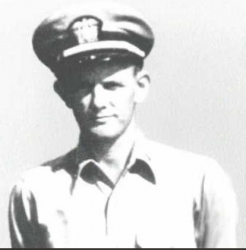 |
|
|
||
|
RANDOLPH MITCHELL HOLDER |
||||
|
Engagements: • World War II (1941 - 1945) |
||||
| Biography: | ||||
|
Randolph Mitchell Holder Ensign, United States Naval Reserve Navy Cross Randolph Mitchell was the youngest child of William Dunbar Holder and Annette Aldridge Limerick who married 15 Jun 1904 in Jefferson County, MS. Randolph's four siblings were Annette Michel, Dorothy D., John L., Benjamin Humphrey. Randolph attended Mississippi State University in Starkville, MS after graduating from Central High School in Jackson, MS on 31 May 1935. He graduated from State on 22 May 1939 with a Bachelor of Science degree in Aeronautical Engineering. He was a member of Beta Kappa. He served on the Engineer’s Day Committee and was a member of the Aeronautical Club, 3, 4. In 1947, the Reveille yearbook was dedicated to the memory of those sons of Mississippi State who did not return to play their parts in her rise to unexcelled heights. Ltjg Randolph M. Holder was listed on the" In Memoriam Page". Shortly after college graduation, Randolph entered the US Naval Reserve Aviation Training Program (V-5), (NSN: 407-27-99), on 13 Jun 1939 in New Orleans, LA as a Seaman 2c. He arrived at the Naval Reserve Aviation Base Miami on 15 Jun 1939 to begin Elimination training. He successfully completed the initial phase of his qualification training on 14 July 1939. He was ordered to inactive duty to await orders to begin basic, ground school and primary flight training at Naval Air Station (NAS) Pensacola. Those orders came in early August 1939 after which he was discharged to accept an appointment as an aviation cadet on 14 Aug 1939 with a date of rank of 3 Aug 1939. He reported to NAS Pensacola for active duty undergoing training on 28 Aug 1939. He completed flight training under instruction and received his naval aviator designation (Heavier-Than-Air) on 27 Feb 1940. He was Naval Aviator #6322. He was detached from NAS Pensacola and transferred to NAS Miami's Advanced Training Specialized Carrier Group for specialized training for future carrier based aviators. After he completed that training at NAS Miami, he was commissioned an Ensign, USNR, AV-(N) on 10 April 1940. He finished second in a class of 14. His date of precedence was 01 April 1940. He was detached from NAS Miami the same day and reported for duty to Torpedo Squadron Six (VT-6) on board the aircraft carrier USS Enterprise (CV-6) on 29 April 1940. Ensign Holder was promoted to Lieutenant Junior Grade (Ltjg) on 28 May 1942. His date of rank would have been 15 April 1942. However, Ensign Holder was neither able to execute the oath of office for the next high rank nor sign the acceptance of the promotion. He could not be promoted until he returned to naval jurisdiction, which he never did. The 1943 Naval Register lists his rank as Ensign. The Enterprise was commissioned on 12 May 1938. Torpedo Squadron Six (VT-6) was commissioned on 01 July 1938. During 1938-1939, Enterprise and her embarked squadrons conducted shake down cruises and workup exercises at various times in the Atlantic and Caribbean operating areas. While the ship was inport the squadrons were temporarily based ashore at their assigned airfields. In Sep 1939, Enterprise became part of the Hawaiian Detachment of the U.S. Fleet whose homeport was Pearl Harbor. In Jan 1940 Enterprise was engaged in exercises in Hawaiian waters. In early Feb, she steamed for Puget Sound Navy Shipyard for an overhaul after making a brief port call in San Diego. In late May, Enterprise, her overhaul completed, returned to San Diego for about a month. She returned to Pearl Harbor on 2 July 1940. Enterprise conducted exercises from August to early Nov in the Hawaiian area. Then on 09 Nov she steamed to San Diego until 2 Dec when she got underway for the Puget Sound Navy Shipyard in Bremerton, WA. Enterprise returned to Pearl Harbor on 21 Jan 1941. During 1941 Enterprise made 13 round trips between Hawaii and San Diego from April - Nov conducting exercise cycles and squadron work-ups. During those months she also shuttled Army Air Force P-39s and P-40s, as well as, Navy aircraft from US West Coast ports to Pearl Harbor and beyond. On 28 Nov 1941, Enterprise, now operating in a war-time steaming condition, left San Diego with a cargo of Marine Fighting Squadron 211 (VMF-211) aircraft and pilots destined for Wake Island. The Marine pilots and their planes flew from Enterprise to Wake Island on 02 Dec 1941. Enterprise was scheduled to arrive back in Pearl Harbor on 06 Dec, but was delayed due to inclement weather. Fortunately, she wasn't inport on the morning of 07 Dec, but arrived later that evening. In the first five months of 1942, Enterprise and her Air Group participated in the Gilbert and Marshall Islands and Wake Island operations in Feb 1942. According to a Report After Battle narrative submitted by VT-6 on 2 Feb 1942, Ens Holder, flying aircraft 6-T-12 configured as a bomber, along with eight other torpedo bombers, each carrying 3-500 lb bombs, launched at 0510 on 01 Feb 1942 to attack combatant ships, and shore facilities on Kwajalein Island by horizontal bombing profiles. After returning to Enterprise, the nine aircraft of VT-6 launched again about 0935 to attack the air field and surface ships at Wotje Island and Atoll. During both attacks VT-6 bombers were met with intense anti-aircraft fire from numerous locations. Ens. Holder received (posthumously) the Navy Air Medal for meritorious achievement during these attacks. In March Enterprise attacked Marcus Island and in April she supported the Doolittle raid. In early May, Enterprise and Hornet were directed to the South Pacific to assist aircraft carriers USS Lexington (CV-2) and USS Yorktown (CV-5) engaged in the battle of the Coral Sea. The battle was over before they could arrive on-scene. After participating in additional operations in the Central Pacific, Enterprise returned to Pearl Harbor on 26 May and began intensive preparations to meet an expected Japanese thrust at Midway Island. Enterprise got underway from Pearl Harbor on 28 May 1942, and with USS Hornet (CV-8), steamed toward a point Northeast of Midway called "Point Luck." USS Yorktown (CV-5) followed a short time later. Early on the morning of 4 Jun 1942, pilot Ensign Holder and his radioman-gunner ARM3 Gregory Joseph Durawa launched their torpedo plane from Enterprise along with other members of VT-6 and Air Group Six to attack the Japanese striking force that was near Midway. Separated from their covering fighter protection, VT-6 comprised of 14 torpedo planes pressed their attack even though overwhelmed by superior numbers of Japanese fighter aircraft. One by one, the planes of VT-6 were shot down. Of the 14 planes, only four returned to Enterprise. Ens Holder and Petty Officer Durawa did not return. According to the USS Enterprise after action report for the Battle of Midway dated 8 Jun 1942 for VT-6, Ens. Holder was declared missing in action on 04 Jun 1942. His remains were unrecoverable. On 05 Jun 1943 Holder was declared presumed dead. On 18 Jun 1942, the Navy Department notified his next of kin via telegram that he was missing in the line of duty in operations against the enemy. Of the 14 Torpedo Bombers from VT-6 that attacked the Japanese Striking Force on 4 Jan 1942 only four returned to Enterprise. Machinist Albert Walter Winchell (NAP), and his gunner, Aviation Radioman 3rd Class Douglas M. Cossitt, made a water landing before sighting Enterprise. They survived 17 days on the open seas in a rubber raft before being rescued by a Patrol Squadron 24 PBY on 21 Jun 1942, some 360 miles northward of Midway. In all, five VT-6 crews survived the morning attack. Ensign Holder was awarded (Posthumously) the Navy Cross, Purple Heart, Naval Air Medal, Navy/Marine Corps Presidential Unit Citation with ribbon, American Defense Service Medal, Asiatic-Pacific Campaign medal with one bronze battle star, and the World War II Victory Medal. ------------------------------------------ Those pilots and crew of VT-6 that were killed in action on 04 June 1942 were: 1) Lcdr Eugene Elbert Lindsey (CO VT-6) and his gunner, ARMC Charles Tilden Grenat 2) Lt Arthur Vincent Ely (VT-6 XO) and his gunner, RM3Arthur Richard Lindgren 3) Lt Paul James Riley and his gunner, ARM2 Edwin John Mushinski 4) Ltjg John Thomas Eversole and his gunner, RM2 John Udell Lane 5) Ensign Randolph Mitchell Holder and his gunner, ARM3 Gregory Joseph Durawa 6) Ltjg Severin Louis Rombach and his gunner, ARM2 Wilburn Forrest Glenn 7) Ltjg Lloyd Thomas and his gunner, ARM2 Harold Francis Littlefield 8) Ensign John Wiley Brock and his gunner, ARM3 John Melville Blundell 9) Ensign Flourenoy Glenn Hodges and his gunner, RM2 John Hail Bates ---------------------------------- Combat Action Ribbon (CR) note: None of the Navy/Marine flight crews in the Battle of Midway were eligible for or were awarded the Combat Action Ribbon (CR). See Navy and Marine Corps Awards Manual (SECNAVINST M-1650.1 of 16 Aug 2019, Appendix 2C.1.c (3) Amplifying Guidance). It reads in part, “The CR will not be awarded in connection with aerial flight, . . . “ The CR was established in 1969 and made retroactive to 07 Dec 1941. ------------------------------ Navy Cross Citation: The President of the United States takes pleasure in presenting the Navy Cross to Randolph Mitchell Holder, Ensign, U.S. Naval Reserve for service as set forth in the following CITATION" "For extraordinary heroism and distinguished service beyond the call of duty as a pilot of Torpedo Squadron Six in the 'Air Battle of Midway,' against enemy Japanese forces on 4 June 1942. Grimly aware of the hazardous consequences of flying without fighter protection, and with insufficient fuel to return to his carrier, Ensign Holder, resolutely, and with no thought of his own life, delivered an effective torpedo attack against violent assaults of enemy Japanese aircraft and against an almost solid barrage of antiaircraft fire. His courageous action, carried out with a gallant spirit of self-sacrifice and a conscientious devotion to the fulfillment of his mission, was a determining factor in the defeat of the enemy forces and was in keeping with the highest traditions of the United States Naval Service." General Orders: Bureau of Naval Personnel Information Bulletin No. 309 (December 1942) --------------------------------------- The Presidential Unit Citation awarded to the crew of USS Enterprise and her embarked Air Wing Six. The citation reads: "For consistently outstanding performance and distinguished achievement during repeated action against enemy Japanese forces in the Pacific war area, 7 December 1941, to 15 November 1942. Participating in nearly every major carrier engagement in the first year of the war, the Enterprise and her air group, exclusive of far-flung destruction of hostile shore installations throughout the battle area, did sink or damage on her own a total of 35 Japanese vessels and shot down a total of 185 Japanese aircraft. Her aggressive spirit and superb combat efficiency are fitting tribute to the officers and men who so gallantly established her as an ahead bulwark in the defense of the American nation." Actions of the Enterprise mentioned in the citation include the Gilbert and Marshalls of 01 Feb 1942; Wake Island raid, 24 Feb 1942; Marcus Island raid, 04 Mar 1942; Battle of Midway, 4-6 Jun 1942; Occupation of Guadalcanal, 7-8 Aug 1942; Battle of Stewart Islands, 24 Aug 1942; Battle of Santa Cruz Islands, 26 Oct 1942; and Battle of Solomon Islands, 14-15 Nov 1942. ---------------------------------------- His family also received a commemoration from President Franklin D. Roosevelt. It reads: In grateful memory of Randolph Mitchell Holder, who died in the service of his country, SEA, Pacific Area, ATTACHED U.S.S. ENTERPRISE, 5 JUNE 1943 (Presumed). He stands in the unbroken line of patriots who have dared to die that freedom might live and grow and increase its blessings. Freedom lives, and through it, he lives -- in a way that humbles the undertakings of most men. (Signed) Franklin D. Roosevelt, President of the United States of America ----------------------------- Air Medal Citation The President of the United States takes pride in presenting the AIR MEDAL posthumously to Ensign Randolph Mitchell Holder, United States Naval Reserve, for services as set forth in the following CITATION: "For meritorious achievement in aerial flight as Pilot of a Torpedo-Bombing Plane in Torpedo Squadron SIX, attached to the U.S.S. Enterprise, in action against enemy Japanese forces in the vicinity of Kwajelein and Wotje Atolls, Marshall Islands, February 1, 1942. Participating in a fighter strike against Japanese ships and bases, Ensign Holder made repeated attacks on each objective until all his bombs were expended and, despite intense antiaircraft fire, succeeded in inflicting extensive damage on enemy ships and air base installations. His courage and devotion to duty were in keeping with the highest traditions of the United States Naval Service." For the President, (signed) James Forrestal Secretary of the Navy Note: Ensign Holder had originally been awarded a CINCPAC Letter of Commendation (LOC) for meritorious achievement. However, in a letter dated 19 Dec 1946 from the Board of Review of Decorations and Medals to the Navy Department, Board of Decorations and Medals and approved by SECNAV, nine officers from VT-6 were upgraded to the Air Medal from the CINCPAC LOC. Ensign Randolph M. Holder was one of those whose LOC was upgraded. The LOC with ribbons previously awarded were recalled. His family received the Air Medal in early 1947. The citation above is from Ens. William Creamer's record. But, each of the officers received the same citation. ------------------------------- Task Force 16 Citation Recognizing its contribution to the Doolittle Raid, 18 April 1942 On the occasion of the 50th anniversary of the Second World War, it is appropriate that we take time to reflect on the unique and daring accomplishments achieved early in the war by Task Force 16. Sailing westward under sealed orders in April 1942, only four months after the devastating raid on Pearl Harbor, Task Force 16, carrying sixteen Army B-25 bombers, proceeded into history. Facing adverse weather and under constant threat of discovery before bombers could be launched to strike the Japanese homeland, the crews of the ships and LTC Doolittle's bombers persevered. On 18 April 1942 at 14:45, perseverance produced success as radio broadcasts from Japan confirmed the success of the raids. These raids were an enormous boost to the morale of the American people in those early and dark days of the war and a harbinger of the future for the Japanese High Command that had so foolishly awakened "The Sleeping Giant." These exploits, which so inspired the service men and women and the nation live on today and are remembered when the necessity of success against all odds is required. (Signed) John H.Dalton Secretary of the Navy 15 May 1995 -------------------------- Two US Navy ships were named in his honor. The first USS Holder (DE-401) was an Edsall-class destroyer. Holder was launched by Brown Shipbuilding of Houston, TX, 27 Nov 1943; sponsored by his mother, Annette Holder; and commissioned 18 Jan 1944. During convoy operations on 11 April 1944 in the Mediterranean, a torpedo from a German plane struck the Holder. Although her crew's damage control teams got control of the situation, the damage was extensive. Naval authorities had Holder towed to New York where she arrived on 9 Jun 1944. Holder was then decommissioned 13 Aug 1944 and was struck from the Naval Vessel Register (NVR) 23 Sept 1944. Holder received one battle star for WWII service. The USS Holder (DD-819), a Gearing-class destroyer, was the second ship to be named after him. She was launched by Consolidated Steel Corp., Orange, TX on 25 Aug 1945 and was sponsored by his mother, Mrs. Annette Holder. Holder was commissioned on 18 May 1946. She participated in notable assignments including the Cuban Missile Crisis, recovery of NASA's unmanned Gemini 2 capsule, Gulf of Tonkin and naval gunfire support off Vietnam, and was a member of the Standing Naval Force Atlantic (NATO high readiness force). The Holder was struck from the NVR on 1 Oct 1976. It was then transferred to Ecuador. She was stricken and broken up for scrap in 1991. [Bio # 147 compiled by Gerry Lawton, GML470] [A big thank you to A. Bowen who provided many of the dates and supplemental information about the short but courageous life of Ltjg Holder.] Bio of Ens. Holder's radioman/gunner, ARM2 Gregory Joseph Durawa, can be found at MHOH Honoree #91420 |
||||
| Honoree ID: 94382 | Created by: MHOH | |||
Ribbons
Medals
Badges
Honoree Photos
 | 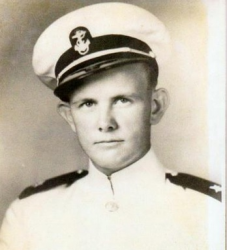 | 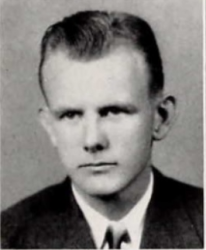 |
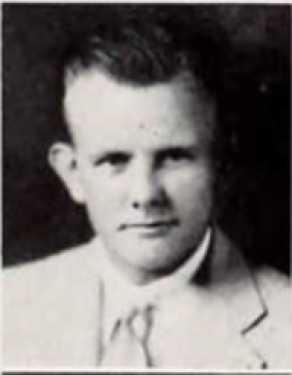 | 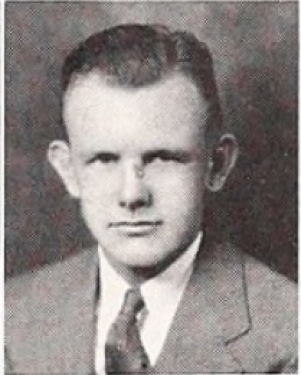 |
 |


